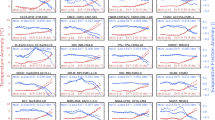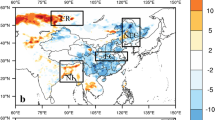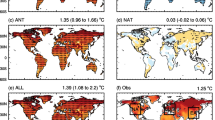Abstract
Land use/land cover change (LULCC) exerts significant influence on regional climate extremes, but its relative importance compared with other anthropogenic climate forcings has not been thoroughly investigated. This study compares land use forcing with other forcing agents in explaining the simulated historical temperature extreme changes since preindustrial times in the CESM-Last Millennium Ensemble (LME) project. CESM-LME suggests that the land use forcing has caused an overall cooling in both warm and cold extremes, and has significantly decreased diurnal temperature range (DTR). Due to the competing effects of the GHG and aerosol forcings, the spatial pattern of changes in 1850–2005 climatology of temperature extremes in CESM-LME can be largely explained by the land use forcing, especially for hot extremes and DTR. The dominance of land use forcing is particularly evident over Europe, eastern China, and the central and eastern US. Temporally, the land-use cooling is relatively stable throughout the historical period, while the warming of temperature extremes is mainly influenced by the enhanced GHG forcing, which has gradually dampened the local dominance of the land use effects. Results from the suite of CMIP5 experiments partially agree with the local dominance of the land use forcing in CESM-LME, but inter-model discrepancies exist in the distribution and sign of the LULCC-induced temperature changes. Our results underline the overall importance of LULCC in historical temperature extreme changes, implying land use forcing should be highlighted in future climate projections.













Similar content being viewed by others
References
Alexander LV, Zhang X, Peterson TC et al (2006) Global observed changes in daily climate extremes of temperature and precipitation. J Geophys Res: Atmos 111(D5):D05109. https://doi.org/10.1029/2005JD006290
Andrews T, Betts RA, Booth BB et al (2016) Effective radiative forcing from historical land use change. Clim Dyn 48:3489–3505. https://doi.org/10.1007/s00382-016-3280-7
Avila FB, Pitman AJ, Donat MG et al (2012) Climate model simulated changes in temperature extremes due to land cover change. J Geophys Res: Atmos 117(D4):D04108. https://doi.org/10.1029/2011JD016382
Brovkin V, Boysen L, Arora VK et al (2013) Effect of anthropogenic land-use and land-cover changes on climate and land carbon storage in CMIP5 projections for the twenty-first century. J Climate 26(18):6859–6881. https://doi.org/10.1175/JCLI-D-12-00623.1
Chen L, Dirmeyer PA (2017) Impacts of land-use/land-cover change on afternoon precipitation over North America. J Clim 30(6):2121–2140. https://doi.org/10.1175/JCLI-D-16-0589.1
Christidis N, Stott PA, Hegerl GC et al (2013) The role of land use change in the recent warming of daily extreme temperatures. Geophys Res Lett 40(3):589–594. https://doi.org/10.1002/grl.50159
Davin EL, Seneviratne SI, Ciais P et al (2014) Preferential cooling of hot extremes from cropland albedo management. Proc Nat Acad Sci 111(27):9757–9761. https://doi.org/10.1073/pnas.1317323111
Deo RC, Syktus JI, McAlpine CA et al (2009) Impact of historical land cover change on daily indices of climate extremes including droughts in eastern Australia. Geophys Res Lett 36(8):L08705. https://doi.org/10.1029/2009GL037666
Donat MG, Alexander LV (2012) The shifting probability distribution of global daytime and night-time temperatures. Geophys Res Lett 39(14):L14707. https://doi.org/10.1029/2012GL052459
Donat MG, Alexander LV, Yang H et al (2013a) Updated analyses of temperature and precipitation extreme indices since the beginning of the twentieth century: The HadEX2 dataset. J Geophys Res: Atmos 118(5):2098–2118. https://doi.org/10.1002/jgrd.50150
Donat MG, Alexander LV, Yang H et al (2013b) Global land-based datasets for monitoring climatic extremes. Bull Amer Meteor Soc 94(7):997–1006. https://doi.org/10.1175/BAMS-D-12-00109.1
Feddema JJ, Oleson KW, Bonan GB et al (2005) The importance of land-cover change in simulating future climates. Science 310(5754):1674–1678. https://doi.org/10.1126/science.1118160
Fischer EM, Knutti R (2015) Anthropogenic contribution to global occurrence of heavy-precipitation and high-temperature extremes. Nature Clim Chang 5(6):560–564. https://doi.org/10.1038/nclimate2617
Fischer EM, Beyerle U, Knutti R (2013) Robust spatially aggregated projections of climate extremes. Nature Clim Change 3(12):1033–1038. https://doi.org/10.1038/nclimate2051
Foken T (2008) The energy balance closure problem: an overview. Ecol Appl 18(6):1351–1367. https://doi.org/10.1890/06-0922.1
Herring SC, Hoell A, Hoerling MP et al (2016) Explaining extreme events of 2015 from a climate perspective. Bull Amer Meteor Soc 97(12):S1–S145. https://doi.org/10.1175/BAMS-ExplainingExtremeEvents2015.1
Hirsch AL, Wilhelm M, Davin EL et al (2017) Can climate-effective land management reduce regional warming? J Geophys Res: Atmos 122(4):2269–2288. https://doi.org/10.1002/2016JD026125
Hoerling M, Kumar A, Dole R et al (2013) Anatomy of an extreme event. J Clim 26(9):2811–2832. https://doi.org/10.1175/JCLI-D-12-00270.1
Holtslag B (2006) Preface: GEWEX atmospheric boundary-layer study (GABLS) on stable boundary layers. Bound-Layer Meteorol 118(2):243–246. https://doi.org/10.1007/s10546-005-9008-6
Hurtt GC, Chini LP, Frolking S et al (2011) Harmonization of land-use scenarios for the period 1500–2100: 600 years of global gridded annual land-use transitions, wood harvest, and resulting secondary lands. Clim Chang 109(1):117–161. https://doi.org/10.1007/s10584-011-0153-2
Kharin VV, Zwiers F, Zhang X et al (2013) Changes in temperature and precipitation extremes in the CMIP5 ensemble. Clim Chang 119(2):345–357. https://doi.org/10.1007/s10584-013-0705-8
Kyselý J, Plavcová E (2012) Biases in the diurnal temperature range in Central Europe in an ensemble of regional climate models and their possible causes. Clim Dyn 39(6):1275–1286. https://doi.org/10.1007/s00382-011-1200-4
Lawrence PJ, Feddema JJ, Bonan GB et al (2012) Simulating the biogeochemical and biogeophysical impacts of transient land cover change and wood harvest in the community climate system model (CCSM4) from 1850 to 2100. J Clim 25(9):3071–3095. https://doi.org/10.1175/JCLI-D-11-00256.1
Lawrence DM, Hurtt GC, Arneth A et al (2016) The land use model intercomparison project (LUMIP) contribution to CMIP6: rationale and experimental design. Geosci Model Dev 9(9):2973–2998. https://doi.org/10.5194/gmd-9-2973-2016
Lejeune Q, Seneviratne SI, Davin EL (2017) Historical land-cover change impacts on climate: comparative assessment of LUCID and CMIP5 multimodel experiments. J Clim 30(4):1439–1459. https://doi.org/10.1175/JCLI-D-16-0213.1
Li X, Chen H, Liao H et al (2017) Potential effects of land cover change on temperature extremes over Eurasia: current versus historical experiments. Int J Climatol 37:59–74. https://doi.org/10.1002/joc.4976
Mahmood R, Pielke RA, Hubbard KG et al (2014) Land cover changes and their biogeophysical effects on climate. Int J Climatol 34(4):929–953. https://doi.org/10.1002/joc.3736
Meehl GA, Washington WM, Ammann CM et al (2004) Combinations of natural and anthropogenic forcings in twentieth-century climate. J Climate 17(19):3721–3727. https://doi.org/10.1175/1520-0442(2004)017<3721:CONAAF>2.0.CO;2
Mueller ND, Butler EE, McKinnon KA et al (2015) Cooling of US Midwest summer temperature extremes from cropland intensification. Nature Clim Chang 6:317–322. https://doi.org/10.1038/nclimate2825
National Academies of Sciences, Engineering, and Medicine (NAS) (2016) Attribution of extreme weather events in the context of climate change. The National Academies Press, Washington, DC. https://doi.org/10.17226/21852
Oleson K (2012) Contrasts between urban and rural climate in CCSM4 CMIP5 climate change scenarios. J Clim 25(5):1390–1412. https://doi.org/10.1175/JCLI-D-11-00098.1
Otto-Bliesner B, Brady EC, Fasullo J et al (2016) Climate variability and change since 850 CE: an ensemble approach with the community earth system model. Bull Amer Meteor Soc 97(5):735–754. https://doi.org/10.1175/BAMS-D-14-00233.1
Pincus R, Forster PM, Stevens B (2016) The radiative forcing model intercomparison project (RFMIP): experimental protocol for CMIP6. Geosci Model Develop 9(9):3447–3460. https://doi.org/10.5194/gmd-9-3447-2016
Pitman A, Noblet-Ducoudré ND, Avila F et al (2012) Effects of land cover change on temperature and rainfall extremes in multi-model ensemble simulations. Earth Syst Dyn 3(2):213–231. https://doi.org/10.5194/esd-3-213-2012
Schultz NM, Lawrence PJ, Lee X (2017) Global satellite data highlights the diurnal asymmetry of the surface temperature response to deforestation. J Geophys Res: Biogeosci 122:903–917. https://doi.org/10.1002/2016JG003653
Shiogama H, Stone DA, Nagashima T et al (2013) On the linear additivity of climate forcing-response relationships at global and continental scales. Int J Climatol 33(11):2542–2550. https://doi.org/10.1002/joc.3607
Sillmann J, Kharin VV, Zhang X et al (2013a) Climate extremes indices in the CMIP5 multimodel ensemble: Part 1. Model evaluation in the present climate. J Geophys Res: Atmos 118(4):1716–1733. https://doi.org/10.1002/jgrd.50203
Sillmann J, Kharin VV, Zwiers FW et al (2013b) Climate extremes indices in the CMIP5 multimodel ensemble: Part 2. Future climate projections. J Geophys Res: Atmos 118(6):2473–2493. https://doi.org/10.1002/jgrd.50188
Stocker TF, Qin D, Plattner G-K, Tignor M, Allen SK, Boschung J, Nauels A, Xia Y, Bex V, Midgley PM (eds.) (2013) Climate change 2013: the physical science basis. Contribution of working group I to the fifth assessment report of the intergovernmental panel on climate change. Cambridge University Press, Cambridge, pp 1535
Stone DA, Weaver AJ (2002) Daily maximum and minimum temperature trends in a climate model. Geophys Res Lett 29(9):70-1–70-4. https://doi.org/10.1029/2001GL014556
Teuling AJ, Seneviratne SI, Stöckli R et al (2010) Contrasting response of European forest and grassland energy exchange to heatwaves. Nat Geosci 3(10):722–727. https://doi.org/10.1038/ngeo950
Thiery W, Davin EL, Lawrence DM et al (2017) Present-day irrigation mitigates heat extremes. J Geophys Res: Atmos 122(3):1403–1422. https://doi.org/10.1002/2016JD025740
Van Vuuren DP, Edmonds J, Kainuma M et al (2011) The representative concentration pathways: an overview. Clim Change 109(1–2):5–31. https://doi.org/10.1007/s10584-011-0148-z
Vose RS, Easterling DR, Gleason B (2005) Maximum and minimum temperature trends for the globe: An update through 2004. Geophys Res Lett 32(23):L23822. https://doi.org/10.1029/2005GL024379
Zhao M, Pitman AJ (2002) The impact of land cover change and increasing carbon dioxide on the extreme and frequency of maximum temperature and convective precipitation. Geophys Res Lett 29(6):2-1–2-4. https://doi.org/10.1029/2001GL013476
Zhou L, Dickinson RE, Dai A et al (2010) Detection and attribution of anthropogenic forcing to diurnal temperature range changes from 1950 to 1999: comparing multi-model simulations with observations. Clim Dyn 35(7–8):1289–1307. https://doi.org/10.1007/s00382-009-0644-2
Acknowledgements
This study was supported by the National Science Foundation (AGS-1419445). We acknowledge the CESM1(CAM5) Last Millennium Ensemble Community Project and supercomputing resources provided by NSF/CISL/Yellowstone. We also acknowledge the World Climate Research Programme’s Working Group on Coupled Modelling, which is responsible for CMIP, and we thank the climate modelling groups for producing and making available their model output. For CMIP the US Department of Energy’s Program for Climate Model Diagnosis and Intercomparison provides coordinating support and led development of software infrastructure in partnership with the Global Organization for Earth System Science Portals.
Author information
Authors and Affiliations
Corresponding author
Electronic supplementary material
Below is the link to the electronic supplementary material.
Rights and permissions
About this article
Cite this article
Chen, L., Dirmeyer, P.A. The relative importance among anthropogenic forcings of land use/land cover change in affecting temperature extremes. Clim Dyn 52, 2269–2285 (2019). https://doi.org/10.1007/s00382-018-4250-z
Received:
Accepted:
Published:
Issue Date:
DOI: https://doi.org/10.1007/s00382-018-4250-z




